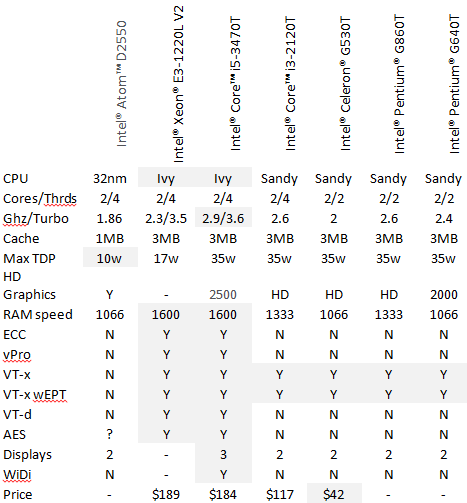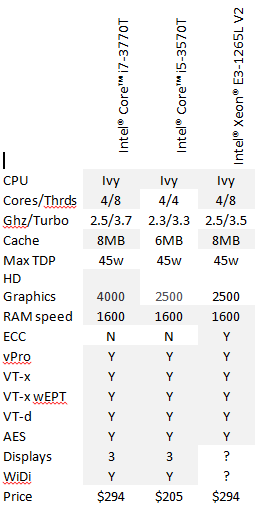Today I am taking a look at Intel’s low powered CPU’s with the intention to show which would suit your low powered build.
I am trying to focus on three categories: HTPC, home server, NAS or other device. The below Intel CPUs are all newly released CPUs, the Core i7 and Core i5 ranges get the new 22nm Ivy bridge treatment, Core i3, Pentium, Celeron and Atom CPUs even though new are still based on the Sandy bridge core, Ivy Bridge versions are replacing them as of the 3rd Quarter of this year. I limited the CPU TDP to a max of 50w for the evaluation as its needing to be a low powered server/HTPC build for the home where power costs will no doubt be a factor for a machine turned on potentially 24/7.


This essentially leaves the Intel Core i7, Intel Core i5 and Intel Xeon E3 CPU’s to battle it out for home server/HTPC. Specifically, only LGA 1155 parts because Intel’s LGA 2011, and AMD’s platforms tend to use more power.
HTPC – Low powered/ priced Desktop
HTPC and desktops are going to need a little bit of everything from a CPU. This can be occasional performance from CPU. They must be low power as they are often turned on 24/7. They must have the ability to show media at up to 1080p with no stuttering pauses or pixelation.
What the comparison shows us above the Intel Core i3, Intel Celeron and Intel Pentium CPUs can be immediately ruled out. Basic Intel HD graphics are not completely trouble-free at 1080p, and these could disappoint.
Keeping an eye on price and performance I would recommend the Core i5-3470T. It’s 35w TDP, fast dual Core with Hyper-Threading. It has Intel HD 2500 Graphics. Fast memory is supported. Overall it fits the bill nicely. The Intel Pentium G640T would make a cheaper solution but with a lesser all round performing CPU. The new Pentium G2120 is another option from the Ivy Bridge generation.
NAS (Network attached Storage)
Network attached storage has simple needs, just grab or store files, often this is done based on a Linux core which is better suited to do this as it runs on a small hardware foot print.
Having a powerful CPU mean that all sorts of protocols can be achieved to varying levels of security needed, NAS devices are often run at various levels of RAID. A low-end CPU would excel here, so the Intel Atom D2550 would be ideal, these CPUs are embeded on motherboards. In most cases mini ITX boards, making for a good small footprint NAS device where a couple of hard drives could be added for RAID 1 mirrored storage, which can be handled by the Intel chipset. This is very similar to what Synology uses with the Atom D2700 in the Synology DS1812+. As a second choice for those looking at something more powerful from their NAS, or file server, then you can’t go past the Intel Xeon E3-1220L v2. It is a dual core with HT. only consuming 17w max power, no built in Graphics which not really needed in a NAS. ECC memory support means extra security in the safety of your data.
Low Power Home Server
The home server is on 24/7 doing all sorts of stuff, streaming out moves, storing photos and movies, storing backups of any computers. It spends a good part of the day idle. Something that is easy on the power use is of benefit. When streaming a movie or two and doing a backup all at once, you’ll want something that is both low power and will perform. Data integrity will be a priority so ECC RAM should be high on the requirement list. The Intel Xeon E3-1265L comes to mind at the top end of low powered server, and the Intel Core i5-3470T should also get a mention.
The Intel Xeon E3-1265L is a great all around option. It has excellent performance. It is supported on most server boards and build in graphics for 2×6 server boards that have the ability to output graphics from the CPU. As a quad core CPU with HT, it’s a good performer, 45w max power use is the lowest of the quad core Xeons.
Another surprising option is the Intel Core i5-3470T, it also has ECC support, very rare for a desktop class processor. This CPU is a dual core with HT. Default clock speeds are good with 3.6Ghz Turbo. It has the same Intel HD 2500 graphics as the Intel Xeon E3-1265L, and uses less power at 35w max TDP. It won’t be supported on many Server boards, but consumer boards that support ECC RAM this might be a good option as often it will also have built in sound and other features making it more of a workstation part.
Conclusion
Hopefully the above can serve as a starting point for deciding on a low power CPU. Each situation is different, but the above is an opinion that you can use to test your thoughts on. Please let us know about any comments or thoughts you may have for the next one as this my first Buyer’s Guide on STH.




Well, how long you must run server to get you money back for high price of this lower power CPU? This was count many times before and offten you realize, that there isnt advantage until you plan run this one specific configuration for decade. Of course it depends on local eletricy bill. You can get more from underwoltage way.
Btw. ecc for home users? I run home server 24/7 for many years with no ecc ram and so far after few days with clear result of memory test I havent any problems or data loss.
Patrick, good article.
I am looking to replace my HTPC but I am considering AMD because of the graphics and cost issue. Waiting for latest chips from them, not sure if they are finished for the year?
@woaaow. I run ECC in almost all of my computers. I had a small server crash and trash one partition of my file system when memory went bad. This was a desktop computer with non-ECC memory. I am old school and ECC memory used to be the normal. I stopped using old desktops for servers. Just my experience.
ECC is a very good idea if you are running software RAID and/or care about the accuracy of your data. For a very basic multimedia server, I would be less worried about ECC vs. non-ECC. I personally use ECC in my main desktop and servers, but not on my gaming computer(single SSD w/ only programs).
Looking quickly, 8GB ECC DDR3-1600 is ~2x the price of 8GB non-ECC DDR3-1600 and 8GB ECC DDR3-1333 is ~1.5x the price of 8GB non-ECC DDR3-1333. When building a small server, RAM is one of the least expensive components and ECC represents a small increase in cost for the added peace of mind.
Victor, appreciate the kind words, but Pieter wrote this article! Credit goes to him. :-)
You missed the best HTPC oriented chip of all — The i3-3225, the one many HTPC enthusiasts had been waiting all year for. Dualcore + Ivy + HD4000 = $120
One problem : Intel Core i5 3470T is unobtainable. Very difficult to found on market or web site.
Good article, but you should have looked at idle power consumption instead of focusing on TDP.
A CPU with twice the power, twice the max TDP but lower or equal idle power consumption is often cheaper and better option to any low TDP CPU for home server/htpc use.
Personally I’m waiting for the very-soon-to-be-released (?) Intel’s Atom Centerton with its ECC support. And this in turn possibly to be sold off a year later for the successor Avoton.
According to my last research, ECC support is no longe rmentioned for the dual core i5 (3470T), and the tests on the chip by nvidiamobile in the forums appear to have all been with negative result.
Are there any signs of ECC actually working on that CPU?
I’d be glad for any confirmation.
Also, two more features, that you might want to include in future rounds-ups:
Intel’s AMT technology allows “native” VNC servers on systems with CPUs with integrated graphics. Very helpful for systems that are run headless, and you need to access the BIOS. The 1220L V2 for example does not support this.
Additionally, while the i3 3xxx dual cores and pentiums support ECC, they lack another feature, that is helpful on storage machines (and technically any machine): AES-NI accelerated encryption.
The advantages of encrypted harddrives are quite obvious, once a HDD has an outage, and as such should be used on any drive in a RAID, for added convenience. With AES-NI it becomes transparent performance and load-wise.
This is also, why I am examining the 3470T so intensely – supposedly (during summer) it supports ECC, AES and AMT in a 35W dual core envelope – with ECC no longer on that list, I may have to shop up to the 1225V2, and more than double my CPU-cooling capacity, while also paying a few dollars more….
(both “vPro” and “AES” feature in the comparison table, but I they should also feature in the commentary in the relevant sections, and especially the vPro-AMT feature has not been discussed at all – the benefits are not known to everyone)
You have laid out good a base article. It would have be even better if you had results on actual power consumption. A follow-up article would be good too.
Nice post. Thanks! I’m looking to build a t.v. server. I don’t think it will need much processing power as the TV tuner cards spew out MPEG 2. Thinking of using MythTV on Linux and running it headless. Four tuners would be idea as well as a few TB’S of storage.
I have a Raspberry pi I’m going to play with, apparently they work quite well, with one tuner. I don’t think it will handle more that two as the network runs off of the USB and is limited to USB 2.0 speeds.
Perhaps something based around an atom processor. Any suggestions as to which, how much ram?
Thanks